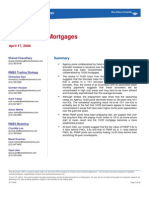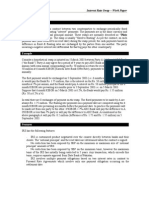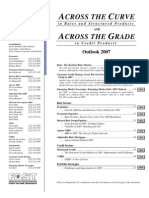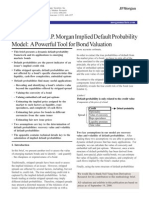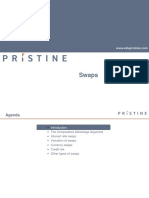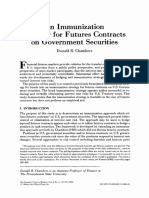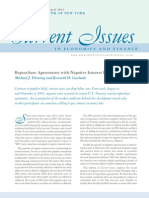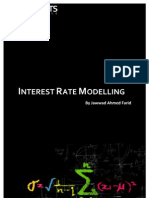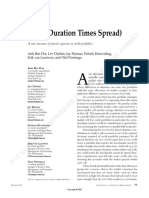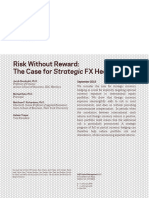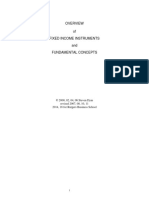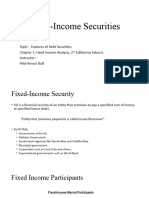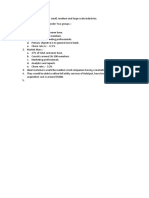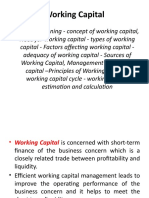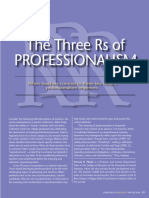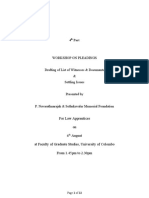UV2257
Rev. May 13, 2015
Pricing Strips and the Term Structure
In the early 1980s, investment banks such as Merrill Lynch and Salomon Brothers began offering what
were effectively zero-coupon bonds by “stripping” U.S. Treasury issues (i.e., separating the coupons from the
principal payments). Once separated, each coupon and each principal payment became separate zero-coupon
bonds. In these cases, the investment banks held the underlying U.S. Treasury note or bond and paid out the
coupon or principal as it was received. Known as receipt products, these bonds had been created by a number
of investment banks and are recognized by such feline names as CATS, TIGRS, COUGARS, and LIONS.1
These products were almost default-free because the investment bank just passed through the flows to
investors, but there was still some default risk since the payment was made by the investment bank to investors.
Such almost default-free financial products provide ideal vehicles for investors such as pension funds and
insurance companies, who may not want to deal with the problems of reinvesting the coupon payments that
accompany U.S Treasury bonds.
Spurred by the innovations of Merrill Lynch and others, the U.S. Treasury, in 1985, introduced its own
coupon-strippable program by designating some of its notes and bonds eligible for stripping. Under this
program, for U.S. government securities (coupon bonds) with maturities of 10 years or more, dealers who held
the original coupon bond were allowed to separately register individual coupon payments and principal as
individual securities. The result was that purchasers were able to receive the payments directly from the U.S.
Treasury and not from the investment banks as in the case of the CATS, and so forth. Known as STRIPS
(Separate Trading of Registered Interest and Principal of Securities), these products became the dominant zero-
coupon instrument. A U.S. Treasury strip is a claim to cash flow at a single maturity date. The cash flow for the
strip is either from the coupon or the principal payment of existing Treasury securities. In 1986, the Treasury
allowed dealers to reconstitute the original bond by purchasing all the coupon and principal STRIPS and then
registering it as the original coupon bond. This bond could then be traded as a coupon bond.
It is important to note that the U.S. Treasury does not directly issue STRIPS. They cannot be purchased
directly from the U.S. Treasury but rather from dealers who buy U.S. Treasury coupon bonds directly and then
register the coupons and principal payments as individual securities. These are then sold through dealers in the
secondary market.
1 CATS (Certificates of Accrual on Treasury Securities), which are proprietary to Salomon Brothers, Inc., represent ownership interest in future
interest and principal payments on selected U.S. government securities. CATS are listed on the New York Stock Exchange and have an active secondary
market. In effect, CATS are zero-coupon bonds and are taxed accordingly. TIGRS (Treasury Investment Growth Receipts) are a Merrill Lynch product
arising from stripping a Treasury bond of its coupons. They are similar in concept and operation to CATS and COUGARS (Certificates on Government
Receipts). COUGARS is a trade name for A. G. Becker Paribas’s U.S. Treasury strips. LIONS (Lehman Investment Opportunity Notes) are a Treasury
strip product marketed by Shearson Lehman Brothers.
Parts of an antecedent note were adapted from James C. Van Horne, Financial Market Rates and Flows, 3rd ed. (Englewood Cliffs, NJ: Prentice-Hall, 1990).
Copyright 1990 by the University of Virginia Darden School Foundation, Charlottesville, VA. All rights reserved. To order copies, send an e-mail to
sales@dardenbusinesspublishing.com. No part of this publication may be reproduced, stored in a retrieval system, used in a spreadsheet, or transmitted in any form or by
any means—electronic, mechanical, photocopying, recording, or otherwise—without the permission of the Darden School Foundation.
This document is authorized for use only in Prof. Raveesh K's Course: Fixed Income Securities (2021) at Indian Institute of Management - Bodhgaya from Sep 2021 to Mar 2022.
� Page 2 UV2257
Transforming coupon bonds into zero-coupon instruments, STRIPS, or reconstituting STRIPS back to the
original coupon bond requires a thorough understanding of the valuation of debt claims. For there to be a
profit in stripping bonds, the sum of the parts must be worth more than the whole bond. To determine this,
each coupon and principal payment should be discounted at the appropriate discount rate for a pure discount
instrument. After the present values of all the coupons and principal payments are summed, this total is then
compared with the market price of the coupon bond. If the sum of the present values exceeds the coupon
bond’s value, stripping the coupon would be profitable. If the sum of the present values of coupons and
principal payments is less than the coupon bond’s value, one would want to reconstitute the bond.
As examples, consider the data in Exhibits 1 and 2 for default-free bonds. An investor wondered what
price might be obtained for cash flows of various maturities. Of further interest was what the current market
revealed about the future course of interest rates. Exhibit 1 shows market pricing of 8% annual coupon bonds
(paying semiannual coupon payments). For instance, the three-year-maturity coupon bond has a price of 98.581
(i.e., 98.581% of face value). At the same time, the market was pricing a three-year-maturity zero-coupon bond
at 77.738 (Exhibit 2).
This document is authorized for use only in Prof. Raveesh K's Course: Fixed Income Securities (2021) at Indian Institute of Management - Bodhgaya from Sep 2021 to Mar 2022.
� Page 3 UV2257
Exhibit 1
Pricing Strips and the Term Structure
8% Coupon Bonds, Semiannual Coupon Payments, $100 Face Value
Bonds Price
FV = 100, coupon 8% (SA), maturity 0.5 years 100.00
FV = 100, coupon 8% (SA), maturity 1.0 year 99.894
FV = 100, coupon 8% (SA), maturity 1.5 years 99.692
FV = 100, coupon 8% (SA), maturity 2.0 years 99.399
FV = 100, coupon 8% (SA), maturity 2.5 years 99.027
FV = 100, coupon 8% (SA), maturity 3.0 years 98.581
FV = 100, coupon 8% (SA), maturity 3.5 years 98.069
FV = 100, coupon 8% (SA), maturity 4.0 years 97.502
FV = 100, coupon 8% (SA), maturity 4.5 years 96.878
FV = 100, coupon 8% (SA), maturity 5.0 years 96.213
Source: Created by case writer.
This document is authorized for use only in Prof. Raveesh K's Course: Fixed Income Securities (2021) at Indian Institute of Management - Bodhgaya from Sep 2021 to Mar 2022.
� Page 4 UV2257
Exhibit 2
Pricing Strips and the Term Structure
Zero-Coupon Bonds, $100 Face Value
Bonds Price
FV = 100, maturity 0.5 years 96.154
FV = 100, maturity 1.0 year 92.354
FV = 100, maturity 1.5 years 88.607
FV = 100, maturity 2.0 years 84.918
FV = 100, maturity 2.5 years 81.294
FV = 100, maturity 3.0 years 77.738
FV = 100, maturity 3.5 years 74.256
FV = 100, maturity 4.0 years 70.855
FV = 100, maturity 4.5 years 67.530
FV = 100, maturity 5.0 years 64.293
Source: Created by case writer.
This document is authorized for use only in Prof. Raveesh K's Course: Fixed Income Securities (2021) at Indian Institute of Management - Bodhgaya from Sep 2021 to Mar 2022.
� Page 5 UV2257
Questions
1. What is the yield to maturity on the two-year and five-year bonds quoted in Exhibit 1?
2. What are the spot rates for the first two years implied by the zero-coupon bonds in Exhibit 2?
3. What are the spot rates for the first two years implied in the coupon bond prices shown in Exhibit 1?
(Use the bootstrap approach to estimate the spot rates.) How do these spot rates compare with those
in question 2?
4. What is the relationship between the yield to maturity on the two-year bond and the spot rates for the
first two years?
5. What is the forward interest rate from month 18 through month 24?
6. Plot the yield curve and the term structure of interest rates implied in Exhibits 1 and 2. What does the
term structure tell you about future interest rates?
This document is authorized for use only in Prof. Raveesh K's Course: Fixed Income Securities (2021) at Indian Institute of Management - Bodhgaya from Sep 2021 to Mar 2022.

